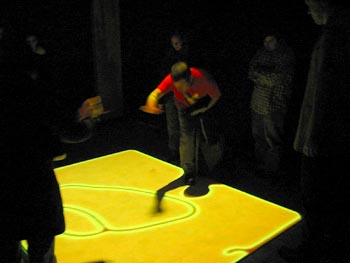Is it alright to review the opening of a show? Is it somehow demeaning to gauge the qualities of an exhibition based on the response of the group that turned out to herald the launch of a new configuration of artworks?
For an exhibition at a space called Art Interactive, for a show titled "Intimachine" that is billed as "The Art of Intimacy, Expectation, and Behavior" it seems most appropriate that the work be discussed in the context for which it was meant: experience through interaction. It is with this in mind that I embark on my attempt to sum up this show.
I'd like to start with the shortcomings. Most notable was "Lay Down" by Victoria Scott. This robotic piece, placed in a corner of the gallery on a floor pattern of concentric rings, never did anything that I witnessed. The object itself appears to be a paper hat on a pole, above a plastic robotic base. Early in the evening it was lying prone on the floor. Later, it stood upright. In neither case did I feel engaged, and judging by the crowd around me, neither did anyone else. At no time did I witness anyone interact with the piece, nor were they confronted by it.
Similarly, Shawn Lawson's "Mona Lisa" failed to engage. Presented as a digital 'painting' in a traditional frame, this faux Mona closed her eyes and slept while viewers ignored her, but blinked slowly awake to eventually stare at those who came close. While I enjoyed the references to the myth that the 'real' Mona Lisa's eyes follow you as you move around the room, the fact that this piece was trying to be interactive seemed contrived and somewhat insulting. Her awakening as a viewer came closer felt like the beginning of something great, yet when she awoke there was... not much.
Still, maybe there is something more here. We have often read that great art engages the viewer, draws them in, makes them confront the world with new eyes. Great art engages because it causes us to consider ourselves in a way we never have before, and it allows us a glimpse through another person's frame for a moment. Sadly, this Mona Lisa stopped us cold, looked back quietly, and offered nothing.
The great success of the show, if one's judgement is based on audience participation, experience and pleasure, is Brian Knep's "Healing Series" piece. This simple video projection reads the shadow of a person as they pass under it (it is projected on the floor) and translates that image into an evolving organic shape that grows around the residue of the interaction. In Knep's own words, this piece "is a sort of organism, and every time someone interacts with it, it's wounded. The piece tries to heal itself, and become whole again."
Watching people play with Knep's work was fascinating, particularly given the artists' idea that to interact with the work is to cause it 'physical' harm. Viewers jumped across the yellow-green surface, jabbed at it with their feet and stabbed it with their hands. I saw a girl do cartwheels across it, and a man work feverishly to cover the entire projected surface with 'wounds'. Most importantly, I saw people having fun with the work, and returning to it again and again to create new images by 'scarring' the virtual flesh.
Knep himself seemed quite casual about the abusive relationship between his audience and his work. More than once he encouraged me, and others, to injure his piece, to make new forms of scars, and to enjoy the process of healing that followed. The writings J.G. Ballard spring to mind, and the analagous relationship of Crash and its fetishised wounds to that of interactive scarring and the visual and virtual joy of watching Knep's organism heal itself.
After experiencing the strange pleasure of Knep's work, the rest of the pieces in the show felt accomplished, and even quite successful, yet somehow hollow. Viewers approached Simon Schiessel's "Haptic Opposition" timidly, and left much the same way. Described as "[a]n obviously useless machine, it nonetheless seems dysfunctional for a participant expecting a certain kind of behavior from a mechanical interface", this piece definitely lives up to the hype. The Jenny Holzer-ish LED screen provided output, and many of us provided input, but the results seemed to always be 'dysfunctional' and therefore disappointing.
Much was the same with Daniel Peltz's "Digital Quilt," a video projection of quilted imagery onto a real quilt surface. Created as a collaboration with 203 RISD students, the piece presents scanned images of bodies as squares of a quilt, as if the surface of the quilt is an ever-changing, always-shifting surface both physical and muteable. As an idea it is fabulous, an artificial skin forever evolving and shedding its layers, becoming new again and again. However, as an interactive experience it is little more than watching video projected onto fabric.
Here is the hard part about writing this review: I love Art Interactive and I want to love this show. However, so much of the work feels as if it has approached the brink of something amazing without crossing over. The idea of "Mona Lisa" as an interactive painting is stunning, but this Mona doesn't really interact. The "Digital Quilt" is an object we all want to touch, but when we do there is nothing more than fabric and light, which is an interesting comment on how our eyes can be fooled but does little for any discourse on "The Art of Intimacy, Expectation, and Behavior."
Watching the crowd play with the interactive work, I was left with only one thought: the "Healing Series" of Brian Knep provides intimacy we want, by allowing our own actions to change the piece (if only temporarily); it fulfills our expectations by responding when we interact with it; but it then grows beyond that interaction with its own behaviors that surprise, amaze and amuse.
After a night of watching countless people interact with work that is meant to be engaged in a physical manner, there seems to be some trouble gauging what interactive work should be. Is it an intellectual pursuit, tantalizing the mind through bodily action? Or is it a fun pursuit, fulfilling the needs of the audience for joy and release, that later become ideas worth pondering? Perhaps it is both, and my own needs prevented me from taking something away from works that were trying to answer other questions. In the end, interactive art is about one's experience with the piece, and while my own responses belong to me, I can only judge the responses of others through observation, which is a flawed process at best. Your experience will not be the same as mine, and to truly judge for yourself you must interact.
Links:
Art Interactive
Brian Knep's blep.com
"Intimachine" is on view November 20th, 2004 - January 30, 2005 at Art Interactive.
All images are courtesy of the Big RED and Shiny.
Matthew Nash is the publisher of Big, Red & Shiny



